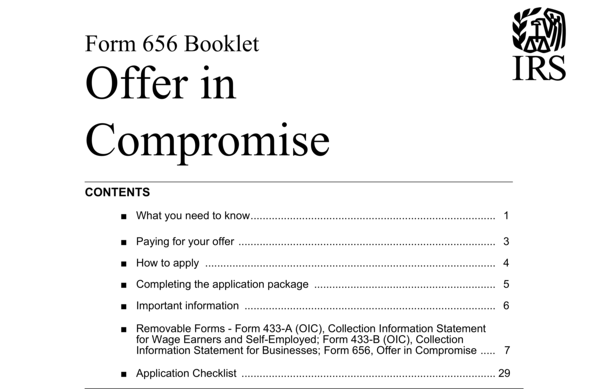Tax Debt is a consistent and debilitating problem for many of us.
So many of us, both as individuals and businesses are drowning in tax debt with no idea of how we can pay it off.
As the pressure of debt continues to build, you may be starting to feel like the IRS is going to come after you any day now.
At this point, it is only natural that you are beginning to look for every possible and legal solution to solving your tax debt problem.
You may have already started researching debt solutions, and you may have already come across a few options.
Perhaps during your research, you may have come across something called an offer in compromise.
An offer in compromise is an IRS tax relief program that allows eligible financially distressed taxpayers to pay off only a percentage of their total debts owed to have their debts settled completely.
An offer in compromise is a form of IRS tax relief that lets a taxpayer who would otherwise face hardships if they paid their debt in full, pay a part of their debt instead of the full amount they owe.
Although this sounds like a fantastic opportunity, it is important to note that not everyone is eligible to apply for an offer in compromise.
The IRS does not merely offer the option of an offer in compromise to everyone who desires it.
Otherwise, nobody would willingly pay their debts in full. Before the IRS accepts an offer in compromise application, the IRS considers several factors.
They look at the applicant’s ability to pay, their level of income, the assets they own, and their expenses.
This gives the IRS an idea of the income of the taxpayer about their debts and if they have the financial ability to pay off their debts without falling into economic hardship.
The IRS also takes into consideration the health of the applicant.
For example, someone who is very ill or disabled and lives on a fixed income would most likely be unable to pay off their full debt after deducting necessary living costs.
The IRS will also consider if the applicant is on the verge of bankruptcy, if they are aged retirees, or if there was an error on the part of the IRS in estimating the value of taxes the individual or business owes.
An offer in compromise application is usually accepted by the IRS when it is the only available option for the US government to reclaim any of the taxpayers’ debts owed.
Simply put, an offer in compromise is accepted when the IRS sees that there is no other way for them to get money owed by the taxpayer in one full payment.
So How do you qualify for an offer in compromise?
For you to qualify for this IRS tax relief program, you need to meet specific eligibility requirements.
You would need to fill out an offer in compromise IRS form and state exactly why you should be considered for an offer in compromise.
To get a better idea of whether or not you would qualify for an offer in compromise, you will have to use the offer in compromise pre-qualifier tool.
The pre-qualifier questionnaire tool presents you with a series of questions to help determine your eligibility status.
Some of the answers to the questions will immediately make you ineligible.
For example, one of the questions asks if you have ever filed for bankruptcy.
If you answer yes to this question, you will be notified of your ineligibility because anyone whose accounts have been filed for bankruptcy is not eligible for an offer in compromise.
You will also be asked if you have filed all of the required federal tax returns, and if you have made all of the essential tax payments that are estimated, and if you have submitted all federal tax deposits that are required for yourself and your employees if you are self-employed and/or an employer of labor.
The next section of the IRS offer in compromise form includes some basic information about yourself such as what state you live in, and your county and zip code.
You will also fill in information regarding the total number of members of your household, the exact amount of IRS tax debt you owe and the most recent tax year you wish to compromise your payment on.
Next, you will be required to fill in information about your assets.
This helps the tax offer in compromise calculator determine the current state of your finances and how much you own.
You might be required to liquidate some of your assets to help raise funds to settle your tax debts; providing a full list of your assets helps the IRS decide which assets you can sell off to pay your debts.
You will also be required to fill in information on your total bank balances, your home equity values, and the value of any financial assets you own.
You will then be required to fill in your sources of income from your job paychecks and or dividends.
After you have correctly filled in information on your assets and income, you will then be required to fill in your expenses.
Expenses include things such as living costs, vehicle payments, public transportation costs, life, and health insurance payments, court-ordered payments, and child dependent care costs.
The IRS will then take all of this information and decide if you qualify for an offer in compromise.
When you apply for an offer in compromise, you are required to pay a filing fee of $150 and a first installment payment of your proposed payment plan.
However, those from low-income households are exempt from paying the application filing fee.
Your filing fee is also determined by the payment option you decide to go with.
There are two payment options:
● Paying a lump sum of 20% of your settlement amount initially and paying the rest in five more installments or less. After paying the initial 20%, the IRS will send you a written notification about your application acceptance. If your application is accepted, you will proceed to pay the rest of your offer amount.
● The second payment option is to pay periodically. Here you pay an initial amount of your choosing and continue to pay the rest of your debt in other monthly installments. You are to keep making these payments until the IRS notifies you that they have accepted your offer in compromise application. You should be able to complete your payments in less than 24 months.
The offer in compromise program has an acceptance rate of 40.03%, so you have a decent chance of being eligible for an offer in compromise yourself.
The IRS would rather get some of your debts paid off than get nothing at all; so if you meet the requirements for an offer in compromise, while there is no 100% guarantee that your offer will be accepted, you will most likely get accepted if the sum you propose to pay is reasonably close to the total amount you owe the IRS.
What can I do if my application for an offer in compromise is rejected?
For reasons best known to them, The IRS sometimes rejects an offer in compromise application even if you filled the form out accurately and are eligible.
While not all offer in compromise applications are accepted, you can file an appeal if your application is rejected and your application may just get accepted on the second try.
You can file a request for an appeal within 30 days of your applications rejection.
If you do not get accepted for an offer in compromise even after filing an appeal, there are other options you can explore for you to pay off your debt to the IRS in installments.
The IRS will examine your assets and income and come up with a monthly plan where payments can be made at an agreed sum every month until you entirely pay off your debt.
Do I need to hire an attorney to help me file?
While researching the offer in compromise, you may have found suggestions about hiring a tax attorney for legal advice and help with filling out your offer in compromise IRS form.
The offer in compromise IRS form is pretty straightforward, and you can decide to fill out and file your application on your own without any getting any legal consult.
However, it might be useful for you to hire a tax attorney to help you out with the paperwork and the tax offer in compromise calculator.
If you find a reputable taxpayer clinic in your area to help guide you through the process of filling out the application, your application could have a higher chance of getting accepted.
How is an offer in compromise sum calculated?
Figuring out exactly how much to offer with your application is an important step.
You do not want to offer the IRS an amount that is too low, so they take your application seriously, but you also do not want to go too high, or you might as well be paying the full sum of your debt.
Finding the right amount to offer is an art, and for that, you need to employ the use of a reliable tax offer in compromise calculator.
Calculating your proposed amount is something anyone can do provided you have the right information and a strong offer in compromise calculator tool.
To calculate the amount you can pay with an offer in compromise calculator, you subtract the value of your total assets from the total debts you owe.
Next, you take the value of your total income per month and multiply it by the number of months you have in the statute of limitations.
The amount you get should be multiplied by 12 of your monthly income as the IRS would prefer to get the full payment within one year.
Now if the total figure you have is less than the amount of debt you owe the IRS, then you qualify for an offer in compromise.
Instead of attempting to manually calculate the value of the offer you want to propose to the IRS, you should use an offer in compromise calculator to avoid any errors.
There are options of tax offer in compromise calculators available online for you to use free of charge.
This offer in compromise calculators give you an estimate of the value of your offer amount and reduce your tax debt.
However, these free offer in compromise calculators are not usually accurate, and as such, you should use a more reliable and precise offer in compromise calculator like the irs.gov offer in compromise calculator.
We highly recommend you use the irs.gov offer in compromise calculator to get the correct value of your offer amount, so you do not have to deal with your offer getting rejected for such an easily fixed error.
Once you input the correct information in the irs.gov compromise calculator, you get the right offer amount you should propose to the IRS, and you can file your application immediately.
Conclusion
Filing for an offer in compromise payment to settle your debts is a great way for you to pay off any taxes you owe the IRS and avoid a lawsuit. Having unpaid taxes is uncomfortable, and one would like to live with the uncertainty of debts hanging over your head.
Using the right offer in compromise calculator helps you determine the right amount to offer the IRS as a compromise payment, so your application is accepted, and so you get to offset your backdated tax payments.










